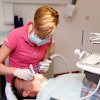
In a report released in late January, the Pew Charitable Trusts listed five issues in dental healthcare to watch in 2016. These issues included midlevel dental providers (MLPs), education standards for dental therapy, school sealant programs, working-age adults, and oral health and aging.
Jane Koppelman, research director for children's dental policy at the Pew Charitable Trusts and co-author of the report, spoke with DrBicuspid.com to discuss these five issues and how they will affect your practice today and into the future.
 Jane Koppelman is the research director for children's dental policy at the Pew Charitable Trusts. Image courtesy of the Pew Charitable Trusts.
Jane Koppelman is the research director for children's dental policy at the Pew Charitable Trusts. Image courtesy of the Pew Charitable Trusts.The topic of midlevel providers remains a divisive issue, with organizations such as the ADA and many state dental organizations opposing authorization to practice for these practitioners.
Koppelman noted that we may well be seeing authorization for MLPs in more states in the coming years.
There is "active legislation" in Massachusetts, New Mexico, and Vermont, she said. "North Dakota will probably be reconsidering it when they convene their Legislature. Overall, there are a growing number of states that are looking at this issue," she added.
One of the interesting trends, Koppelman said, is what she described as "free-market supporters" who are coming out in favor of dental therapy.
For example, Grover Norquist from Americans for Tax Reform (ATR) publically endorsed the concept of dental therapists, she said.
"More and more conservative think tanks and legislators are getting behind the issue of dental therapy. When you consider that most state legislatures are controlled by Republicans, this is very interesting trend," she said.
Koppelman also noted that, during a discussion of MLPs in Massachusetts at a legislative hearing, both the deans of the Harvard and Tufts dental schools came out publically in favor of MLPs.
CODA accreditation
The report's second issue is education standards for dental therapy. This point came about after an August 8 meeting of the Commission on Dental Accreditation (CODA) determined that the accreditation process can begin.
“More and more conservative think tanks and legislators are getting behind the issue of dental therapy.”
"What we see is that CODA's implementation of dental therapy standards was a watershed moment for the dental therapy profession and movement in this country," Koppelman said. "We see that it has already created more interest among state legislatures to authorize these programs."
She noted that it is a kind of virtuous circle, as now more training institutions will likely be consider hosting these training programs and more students would likely be more interested in pursuing this career, as they wanted to make sure they could graduate from an accredited institution.
"It was a major piece of the puzzle that was missing, and it's finally in place," Koppelman said.
Sealant programs
The final three points of the report encompass the age spectrum: school-based sealant programs, oral healthcare of working-age adults, and oral health and aging.
"There are a number of research organizations looking at how to expand the number of school-based sealant programs and how to make them more efficient," Koppelman said.
Sealants came to more general notice in the 1980s, and school-based sealant programs have been shown to reduce decay in 60% of the children who are treated, according to Koppelman.
"As far as a public health intervention program, that is stunning," she said. "The evidence base is there, and it is now a matter of elevating the importance of sealants as decay prevention."
She noted that the Pew Charitable Trusts hopes that the research and activity into school-based sealant programs will spur state- and county-level officials and decision-makers to see how effective these programs can be.
Adult programs
The fourth and fifth points emphasized are for working and older adults. The report cited a study that showed that in 2011 only 36% of working-age adults saw a dentist, a figure that declined as socioeconomic level dropped. The correlation to this is another cited study that reported that the incidence of working-age adults seeking dental care in hospital emergency rooms has risen over the past decade.
This is both an issue for the electorate and states, as much of the money for care in the emergency department ultimately comes out of a state budget, Koppelman noted. This cost for care, nationally, is in the billions of dollars, she added.
"This is completely wasteful spending," she said. "You would hope that lawmakers at the state level would take note."
When it comes to aging adults, the population statistics are well-known. Koppelman said this was an issue to be explored two ways: through the financing and through the delivery system.
"Thirty states have expanded Medicaid coverage to adults, and almost all of those states included some level of oral health," she said. "In most cases it's a very narrow benefits package, and everyone knows that, but it's a start to filling in the gap for dental insurance coverage for the elderly."
The other aspect to look at is the delivery system, whether through innovative programs that bring care to places where older adults live and congregate or through a midlevel provider.
"If you can't get to a dentist, what can be done to bring oral healthcare to the patient?" she said. "More and more we are seeing innovative programs where public dental clinics and private practices are deploying practitioners to these sites."
"We do think there needs to be more creativity in the delivery system," Koppelman said. "Dental therapists can play an active role in extending dental teams to nursing homes and assisted-living facilities and other senior centers where seniors congregate."



















